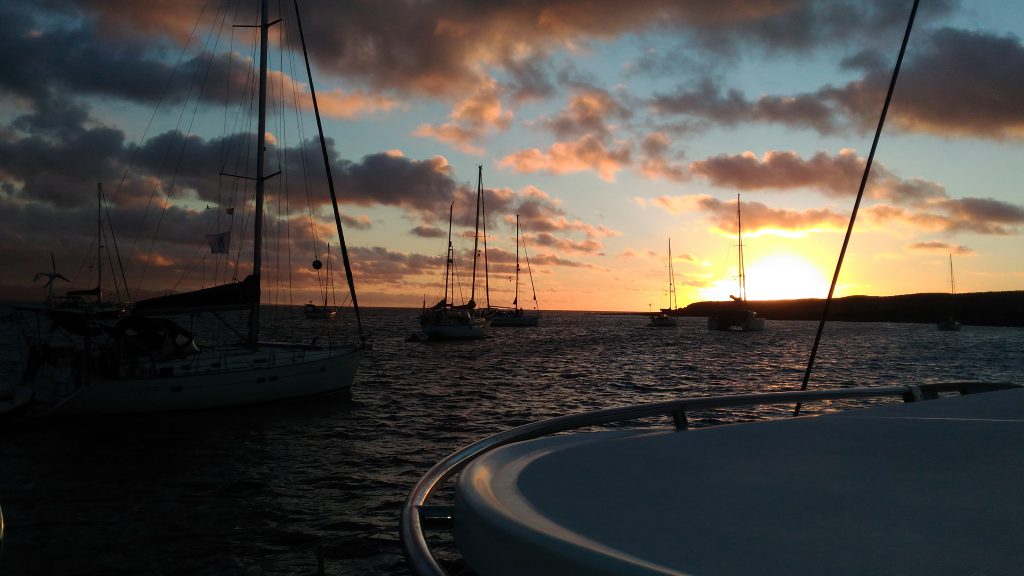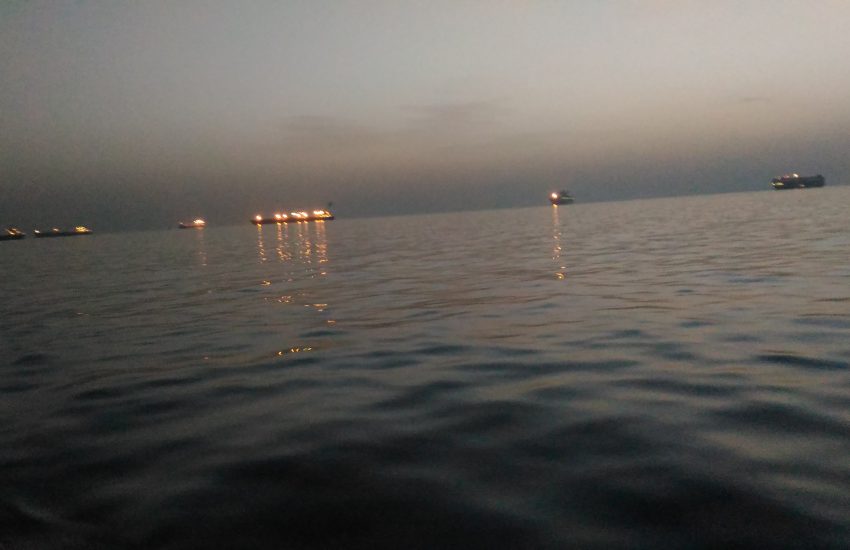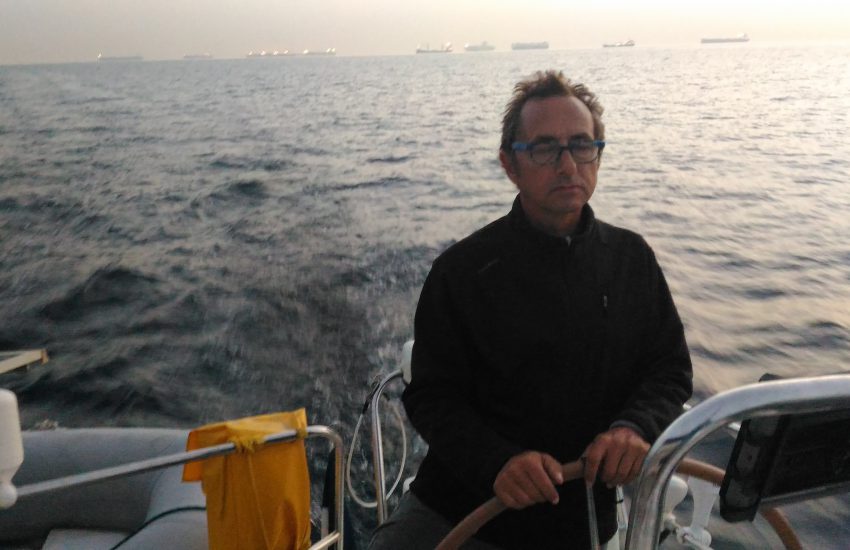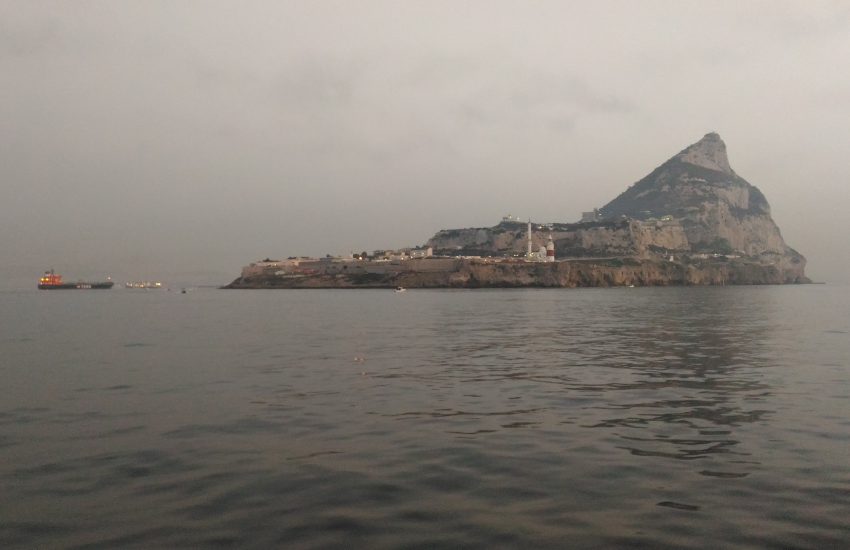Saturday 8 October
We woke up early and left Sotogrande at 6:30 AM, a good 2 hours before the sun rises in the South of Spain. The crossing of the Strait of Gibraltar is a bit complicated and demands some preparation. In the middle of the strait there is a corridor for tankers; its northern strip is for Westbound boats and its southern strip is for boats entering the Mediterranean. Pleasure vessels have the option of navigating in the corridor with the tankers or between the corridor and the Spanish or Moroccan coast. Winds can be Westerly or Easterly. As the water in the Mediterranean is saltier than in the Atlantic, hence heavier, it tends to flow below the incoming ocean water. Also, the water level of the Mediterranean is 1 meter below that of the Atlantic. There is therefore a strong incoming current, but strong Westerly winds can create counter-currents. In addition to all that, the tide also affects the current, and changes hour by hour as the tide rushes into the Mediterranean or out of it. To cross the Strait successfully you must ensure that you have favorable winds or no winds to motor across, and must follow the schedule of the tide to cross with the current.
By leaving at 6:30, we arrived at the rock of Gibraltar towards 8, just before sunrise. That part of the trip went smoothly. It was dark but visibility was good. I was delighted to see rows of lights along starboard-side coast as well as in front of us, which I imagined was Africa, but Pierrick pointed out that those lights were tankers moored at the mouth of the Strait waiting to pass or to enter into a port of Gibraltar. As we approached and the sun came up, I saw that there was indeed about 10 tankers sitting in the sea. We remained close to the coast as we had planned to use the route between the tanker corridor and the Spanish coast and cross the strait Southward at Tarifa, again taking advantage of the southbound current. A few dolphins came to swim along our boat to see us off.
Shortly after passing Gibraltar, a thick fog descended on the water. Visibility was reduced to a few meters. Suddenly we heard the long din of a blow horn right behind us: we were in the corridor used by tankers to leave the port of Gibraltar! We changed direction to exit the corridor as quickly as possible. We navigate using a navigational App that shows the positioning of all boats around us with their AIS signal turned on. When visibility is close to nil, this App is a godsend! As back up we can use the radar on our Raymarine, our GPS technology. Still, someone is always on deck, getting drenched through by the misty air, eyes peeled for any incoming obstacle, listening to the horns of the different tankers navigating around us.
It is only when we arrived at Tarifa that Pierrick noticed that he miscalculated our crossing. We should have left 5 hours before high water (the high tide) but instead crossed at 2 hours before. As we stayed along the coast we were able to take advantage of the coastal current, but once at the Western tip of the strait we were head against the strong easterly current. Trying to cross a tanker corridor counter-current is not a good idea, to put it lightly, so we decided to anchor in Tarifa and waited for 2PM.
When we arrived the fog was still thick and visibility was of only a few meters. We knew we were close to land because we moored next to the buoys that delineated the swimming area (300 meters). And then, from out of the fog appeared two small vessels, a fishing boat and a pneumatic. The crew of these two boats seemed to know each other and they waved to us. I waved back, suspicious of two boats out in the fog that weren’t so much as fishing. Eventually they drifted away and Pierrick and I took a nap. When we woke up the fog had finally lifted, and we could see full well the going-ons of our fellow mariners. While eating lunch, we watch them as they went to land, loaded up black cases that they brought to a bigger vessel, which then sped off to a tanker moored farther out. The two boats we had encountered were two of six boats hauling cargo out to sea in what appeared to be clearly an illegal operation. The port of Tarifa was right behind us, on the other side of a small peninsula. Any legit export would pass through the port. We figured it couldn’t be drugs as that merchandise would be incoming, but we decided we didn’t want to stay around to make friends with these entrepreneurs and took off as quickly as we could. We left these mariners to the military vessel that we saw on our navigational app.
We crossed the strait without any problems but once at the other side fog descended once again, and so we started our route down the North-Eastern tip of the African continent without so much as a glimpse of Tanger. We sailed this way until 7:30 PM; the fog lifted just on time for the sun to start setting.
Our first night at sea there was very little wind, only 4 to 6 knots, so we motored our way along. On our nav App we saw that another catamaran called Twins was following the same route as us. A silent competition began in Pierrick’s mind: to go faster then them! I think all sailors, no matter how good-natured or friendly they main seem at port, has an intrinsic yet firm sense of competition. No matter the setting, they want to be fastest. They want to best take advantage of the winds and seas and sails. My husband is no exception, and nor am I to be honest, except that for our first long crossing I was happy and comforted to see that we weren’t alone on our route.
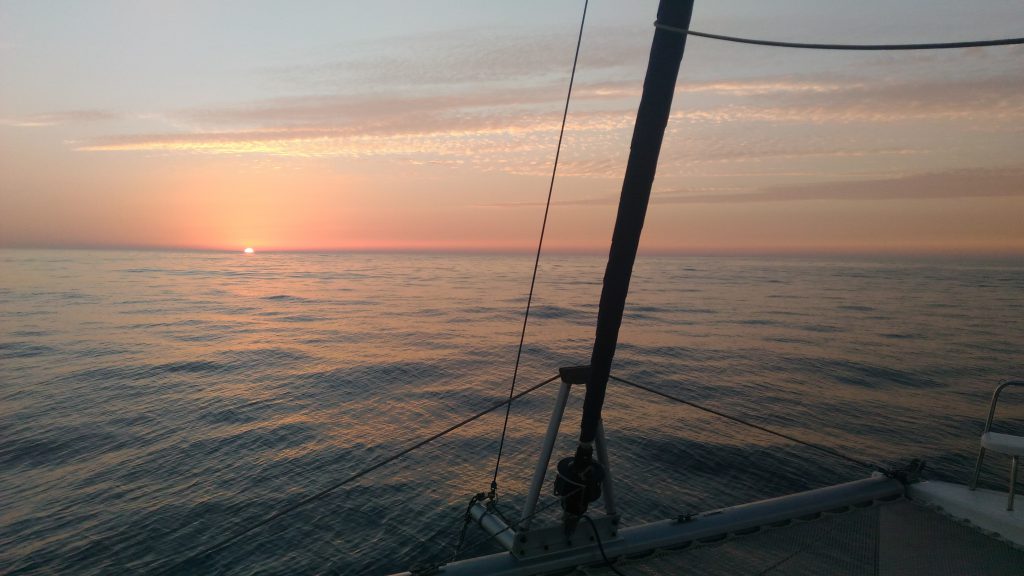
Sunday 9 October 2016
08:00 – 35°12’115N / 007°12’646W
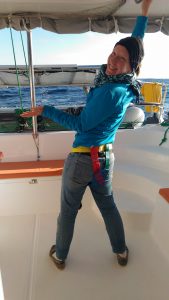

Our shift for the night was 4-2-2-4. I slept from 10 to 2 AM, then I was on deck from 2 to 4. Pierrick took over from 4 to 6, and then me again from 6 to 10. Our logic is that I can easily fall asleep early and like being up at the crack of dawn, whereas Pierrick can stay up late and likes sleeping in. The 2-hour shift is the one I found most difficult. As for my morning shift, once the sun is up I’m fine and can usually let Pierrick sleep in a bit longer, but by noon or 1 PM I need to take a nap. We spend some time together in the afternoon and have dinner together, but most of the rest of the time while crossing one of us is sleeping, so in effect we don’t spend all that much time together. Also, I had decided that while crossing I would not try to do anything else, like work or write or work out. These days were for sailing and while not sailing, resting or sleeping. Considering that I still have severe dizzy spells and that I caught a cold while in Paris, doing much more wouldn’t have been wise.
The wind started gaining strength at around 9 AM. On our nav App I saw that at around 9:30, Twins had turned to face the wind. They had raised their sails. We did the same once Pierrick woke up at 10 and continued our route with the main sail and the geneker. At last we could turn off the noisy motor.
Pierrick decided to stop smoking. He’s using this strip to help jump start the process. Sunday was his first day without cigarettes and he did not bring patches or an electronic cigarette. He’s going cold turkey, commando-style. Sunday was his first smoke-free day.

Monday 10 October 2016
08:10 – 33°33’344N / 009°29’592W

At 1 AM the wind died down and Pierrick brought in all the sails on his own while I slept. Of course, the sound of the motors starting up woke me up. During my 2 to 4 AM shift I noticed that our nav App no longer showed Twins – where did they go? Turns out that when we are far from the coast, the app only shows boats that are within a certain radius, which means that boats traveling at 13 to 30 knots, like tankers and cruise ships (respectively), end up on our App only when within 30 to 60 minutes from us. When a vessel appears on our App we must check the closest point of contact right away and change course if a collision is likely. Vigilance is necessary. This also meant that we were way ahead of Twins!
Monday was a difficult day. The wind and the waves were both coming from the North to NNE and we were sailing at broad reach. We were going quite fast at 6 to 7 knots, but the boat was hitting the waves diagonally, which on a cat can cause a lot of disturbance. When the waves break between the two hulls they slam against them, causing a loud crashing sound and the boat to tremble. Frequent crashing sounds and trembling can seriously put a crew on edge. This doesn’t happen on a mono-hull because it tips to a side and then surfs the waves, and yet sailing when constantly trying to balance yourself is also very tiring. Many people we talked to went on about the advantages of cats. How less tiring and more comfortable they are. We knew they sailed better at broad reach than with a head wind, but nobody mentioned the waves crashing between the hulls with so much uproar.
By the evening Pierrick, who was already irritated by not smoking, lost his cool and started swearing about catamarans and traveling and everything else under the sun. Quickly enough he recouped and figured that our trip would be easier if we sailed in the direction of the waves. At around 8 PM we changed our direction accordingly and, as we now had a full back wind, we put our sails in scissor. The crashing and rumbling subsided substantially. This setting works well but demands constant supervision as a shifting wind can cause the genoa to cross over or the mail sail to jibe. Because of this I was rather nervous when my night shift came up, and that inevitably led to the main sail jibing, which in turn caused the band we use to maintain the main sail at broad reach to split in two. Pierrick, awoken by the noise, came on deck and fixed the band with some extra rope. We rolled up the genoa and continued our route with only the main sail, loosing only 1 knot in speed!

Tuesday 11 October 2016
09:00 – 31°29’234N / 011°05’983W

A much easier day. We sailed most of the day with only the mail sail, raising the geneker in late afternoon when the wind started dying down a bit. At this time, we were honored by a visit from a colony of dolphins. Usually when we see dolphins it is by pack of 5 to 7 and they swim along our boat for 5 to 15 minutes, so we were excited to see about 30 dolphins come to swim by our side! Their numbers eventually died down but at least 8 followed us for over an hour. I stayed on the deck, dolphin spotting.
As we both find our 2-hour shifts to be knackering, we decided to try full night shifts. I would sleep from 9-ish to 4 AM, and then Pierrick would sleep until around 11. This worked great for me, but the next day Pierrick informed me that this was not the best shift break-up for him.

For the longest time I found that sailing was not tiring. Sure, there was the raising and shifting of sails, but unless you’re racing that only happens a few times while out and is not all that tiring. I can say today that long cruises are indeed tiring. First and foremost, the shifts needed to maintain a constant watch screws up your biological clock. Second and more subtly, your body’s constant search for balance eventually takes it toll. Finally, any extremes, like bad weather or major wave crashing between the hulls, will put you on edge and wear down your nervous system, of sorts. And so when you are not keeping watch or making food or eating food, you are sleeping or resting. This is how we spend our time during long cruises. At least, this is how we have spent our time so far.

Wednesday 12 October 2016
08:00 – 30°02’947N / 013°10’573W


I’ve decided to let Pierrick sleep in a bit, so when at 11:30 I first notice the islands ahead of us, I am on my own to rejoice at the sight of land. We’re advancing at a comfortable 5 to 7 knots with our main sail and the genoa. The first island we reach is El Roquete followed by the Isla de Montana Clara, a beautiful mountain island made of dramatic lava stripes. Our destination is the anchorage in front of the Playa Francesca to the south of the Isla Graciosa, a location that sailor friends of ours have lauded for its beauty and tranquility. These islands are part of Lanzarote and the Parque Natural des Archipielago Chinijo. Before arriving we had to address a request to moor in these waters to the Servicio de Medio Ambiante. We filled in the form and sent it off within the requested delay, but never got a response. We’ve decided to chance it and anchor and see if anyone comes to control us.
We arrived at our anchorage at 17:00. There are a dozen other boats, mostly French and Dutch.
We are happy to finally set our anchor and sleep a night together in the same bed! We’ll spend a few days here resting before continuing our travels throughout the Canary Islands. Next stop will be Lanzarote.
